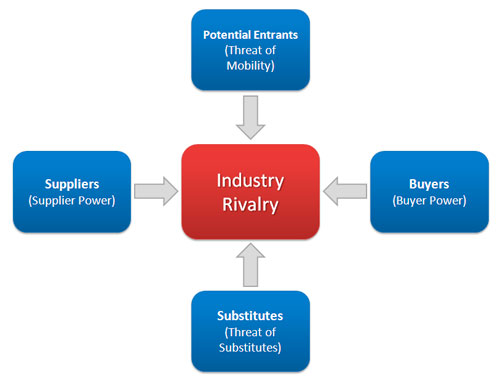A few days ago, HP announced its entrant to the online collaboration market titled HP virtual rooms. This adds to a list of solutions which already comprises Google Apps, Microsoft BPOS, IBM LotusLive, Cisco WebEx, Adobe Acrobat.com, Oracle Collaboration Suite, Salesforce Chatter.com, VMWare’s Zimbra; as well as slightly lesser known players like Zoho, HyperOffice, Jive etc.
Having been in the online collaboration industry for 6 years, and done an MBA degree before that, it was natural for the two to come together in my collaboro-management mind.
Using Porter’s five-force model, a universally accepted model used to analyze markets across the board, on the collaboration market, may yield some interesting insights. The model analyzes every market on five parameters – intensity of competition, barriers to entry, threat from substitutes, bargaining power of customers, and finally bargaining power of suppliers. The first four parameters or forces, act upon the fifth and determine the competitiveness, and hence attractiveness of an industry. The more the competition in an industry, and the closer it approaches conditions of “perfect competition” the lesser the chances of companies earning a profit.

Barriers to entry – As evidenced by the huge number of players in the market, barriers to entry are very low. Costs of developing a product are relatively low, and a few thousand dollars are all that may be needed to create a product and step into the market.
Threat of substitutes – This is a somewhat dicey point. The boundaries of the “online collaboration” market are very vague. Under the banner of “enable remote teams to work together”, just about anything under the sun can be passed off as an online collaboration solution – email, a document manager, social networking sites, activity streams, project management solutions, mind mapping solutions, web conferencing solutions, intranet tools, real time co authoring, IM and more. Recent times have seen a minor convergence of sorts, where solutions integrating many of the above mentioned tools – business email service, document management, project management, workspaces etc – in a single suite have hogged the limelight.
With all these vaguely similar solutions looking to serve the same core need, you can bet the market is packed like sardines in a tin.
Bargaining power of customers – The answer to this is dependent on the particular segment we are talking about. Since many of the players in this segment are mega corporations, the bargaining power of customers is extremely low for the small business segment. But in the enterprise segment, the customers themselves are mega global corps, the bargaining power is a lot more. Therefore, it is hard to make a sweeping statement for the entire industry.
Bargaining power of suppliers – There are no suppliers to speak of in this industry, since all that is needed is an idea, and some coders to get it up and running.
Competitive rivalry – The above forces have come together to ensure that the market is intensely competitive. But given the huge size of the market, which is still relatively nascent, and the prospects of its growth, the market still offers room for profitability.
CONCLUSION
As Porter identified, there are three generic strategies companies can use – differentiation, cost leadership, and focus. These strategies are imminently relevant to companies in this market, and their application is in evidence already in different companies.
Google Apps’ strategy is a mix of differentiation and cost leadership. It seeks to distinguish itself from the market as bringing a purely online collaboration model, where companies would need to give up traditional desktop based document software like MS Office. Also using its economies of scale, it also offers one of the lowest cost products in the market at $50 per user per year.
Microsoft BPOS strategy is that of differentiation, where it has positioned itself as the most complex and powerful platform in the market, especially suitable for enteprprise needs.
A company like HyperOffice follows the focus strategies, where solutions have been developed with a view to small businesses, and a service model has been developed around solutions to serve this segment.




Pankaj: thanks for posting this blog. I like the Porter model, and will be including the framework in an upcoming blog I’m writing about sales. Porter’s method for examining industry forces and their impact on corporate strategy is sorely needed for B2B salespeople.
I would only like to comment that even though online collaboration is broad, fragmented, and new, there are suppliers that could be described similarly. They not only include–as you’ve said–developers and programmers, but also business objects and online software tools that are embedded into collaborative products.
Great explanation of the 5-forces model. I’ll include a link to your post when I write my blog. In the meantime, here’s a link to the one I wrote that leads up to it, Are Salespeople Trigger Event Happy?
Online collaborating and teaching can work, If you have trust and the right tools.
I recently tried http://www.showdocument.com – good app for uploading documents and working on them in real-time.
Most file types are supported and it needs no installation. – andy